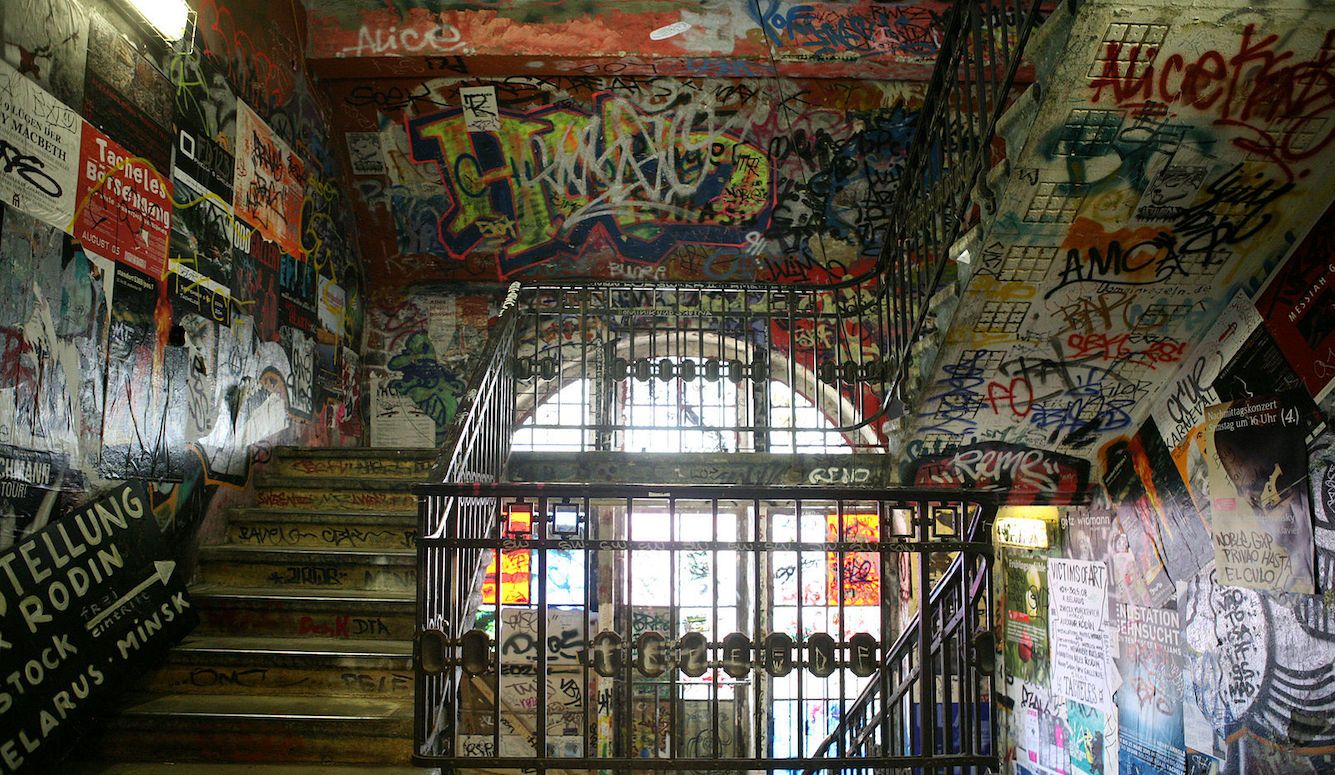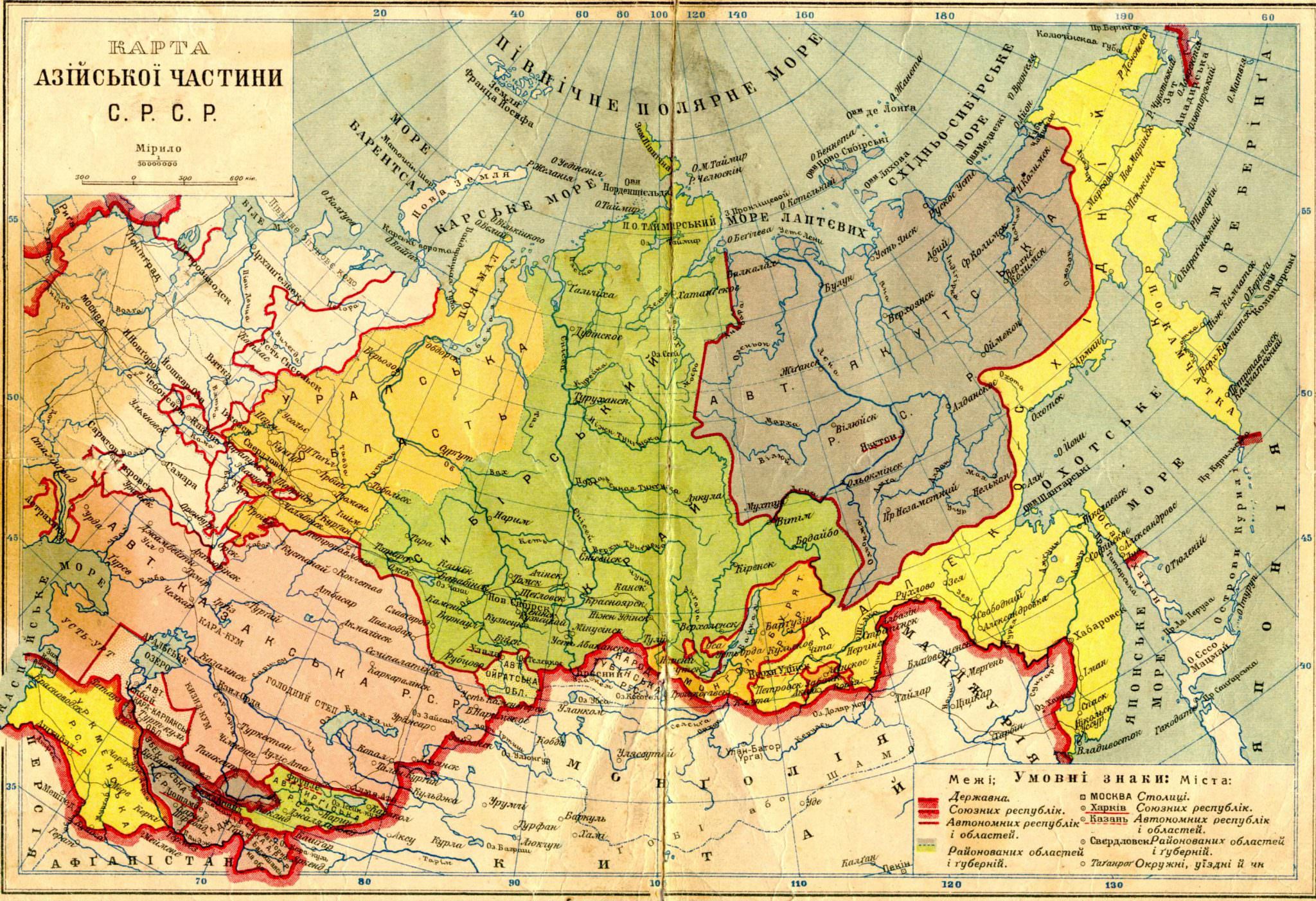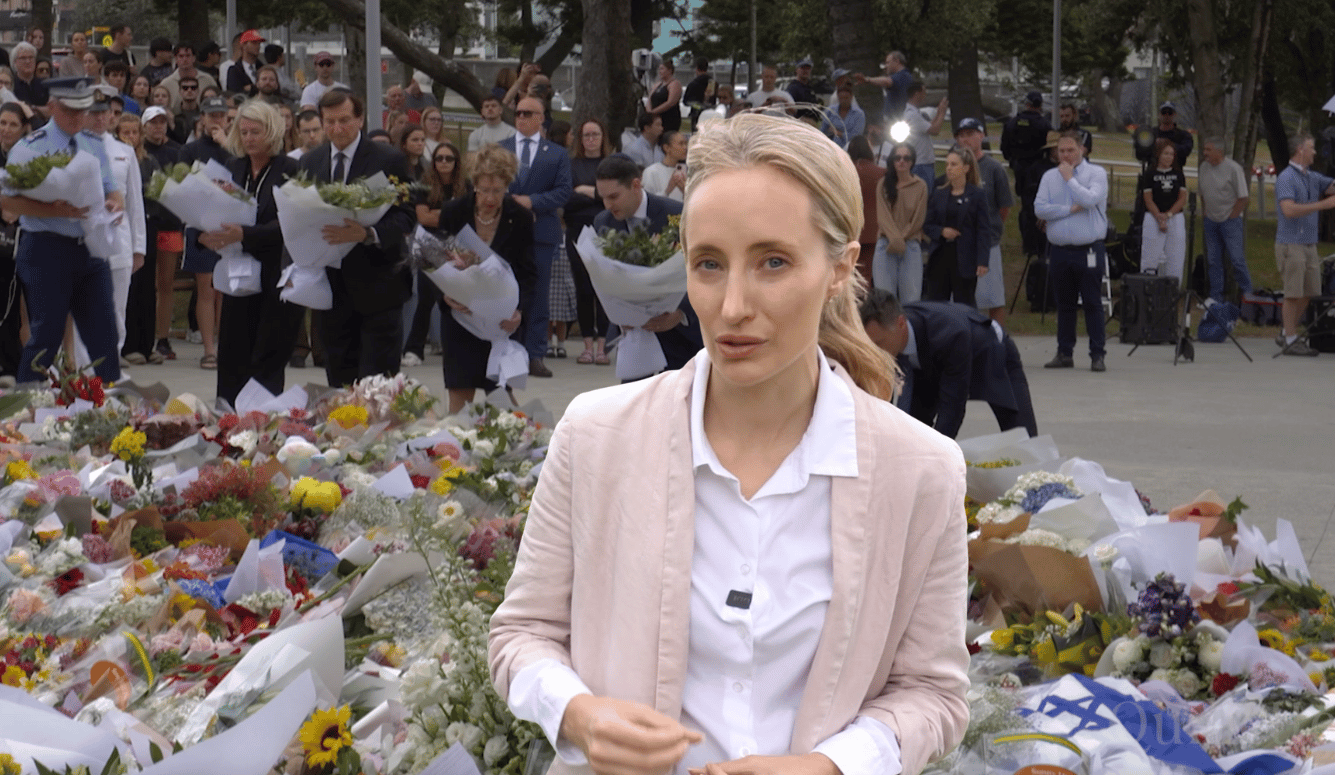Germany
Remembering Berlin’s Post-Communist Art Colony—Before It Became ‘Kitsch for the Rich’
The Berlin winter sky is orange one evening as we turn off Oranienburger Strasse into Tacheles courtyard, where a Trabant is planted nose-first in the sand, a laconic memorial to a lifestyle that no longer exists.

There are days in 1989 when the smell of sulphur hangs in the streets, a reminder that West Berlin is surrounded by the dark continent of the Eastern Bloc, which strikes Westerners as an old, rusting, colourless industrial world populated with smoking chimneys and glum-faced proletarians operating gigantic machines. The German Democratic Republic (GDR)—the Eastern, socialist part of Germany—is the European country with the highest sulphur-dioxide emissions and the highest levels of particulate matter in the air. Since a pocket of air takes mere hours to travel across the city, the majority of the dirt in Berlin’s air is assumed not to have been caused by emissions within the city itself. As long as the power stations and factories are still operating in Czechoslovakia, Bitterfeld, and Leipzig, and while coal is burnt in the tiled stoves of old houses, a yellow-brown haze hangs heavily in the wintry Berlin sky whenever a south-easterly wind blows. The odour is unforgettable.
The deposits of these sulphurous yellow days settle on the house façades, and colour them a pale shade of brown. You can see it all over town, though in West Berlin it is concentrated in poorer districts with large migrant-worker communities. In the East, where the late-19th-century buildings haven’t seen a lick of paint in 50 years, this brownish hue dominates the city centre. It coats your body with dirt. This brown suffuses your clothes after a day in the city; it turns your hands and your bathwater black. Spend the whole day outside, or dance the night away in a cellar somewhere, and there’ll be a black crust to scratch out of the inside of your nose the next morning. Human nostrils and building plaster are the most common magnets for the dirt in Berlin’s air. At night, it turns the sky orange.
It snows heavily for a few days in the winter of 1990–91, and it makes the central Alexanderplatz virtually impassable. The snow appears to have gotten the better of East Berlin city council. The old order has collapsed, and the new one isn’t yet fully in place. A year has gone by from the fall of the Wall to reunification. East Berlin is caught up in a turbulent transitional phase marked by demonstrations, art happenings, and parties. A situation resembling what 19th-century utopians named anarchy has taken hold during the interregnum between systems; an order that appears almost to function without any leadership. Berlin is no longer the capital of the German empire, even though every other street corner in Mitte, the old city center, suggests that it might have been until very recently. Berlin is no longer the capital of the GDR, and not yet the new capital of reunified Germany.
The Berlin winter sky is orange one evening as we turn off Oranienburger Strasse into Tacheles courtyard, where a Trabant is planted nose-first in the sand, a laconic memorial to a lifestyle that no longer exists. In the back wall of the house is an inconspicuous grey steel door, which opens around 11 or 12 at night. I’m not alone—nobody goes dancing on their own. Maybe there are two or three of us. We say hi to the bouncer and wink cagily at the woman on the till. She’s sitting off to the right, just inside the door, huddled in a thick jacket. In front of her is a small metal box. She looks like a secretary guarding a postage meter rather than the most exciting place in Berlin. We head downstairs and step into the passageway at the bottom.

The ceilings are low, the walls unplastered and damp. It smells of cellar, of decades of silence, of cigarette smoke and the spilt beer of past parties. You’re confused the first time you reach this point. Which way? Straight down the tunnel into the pitch black? Or turn right, around the corner? This disorientation turns out to be a trick. There’s no dark tunnel ahead of us, just a mirror standing slanted in a lift shaft. It lures you into believing in a path that doesn’t exist. Then we hear the music. We turn right, around the corner, and we’re inside.
The bass drum pounds stoically, imperiously, at 120 beats per minute. The syncopated sound of a cymbal, running ahead, cutting in early, draws our bodies forward. Individual sounds, fat, rich, and sexy, carve out spaces for themselves between the beats. Slowly our ears grow accustomed to the music. It’s house, on vinyl imported from Chicago or New York. It’s better, simpler, and more seductive than anything we’ve ever heard before. People come in, stand around for a while and say hi to each other. They chat, laugh, drink beer, and then sooner or later they start dancing. They don’t come here to sit around; the only seats are at the cocktail bar. Both the bar and the bar stools are mounted on springs. It’s a challenge to climb up and sit down. Your legs dangle in the air as if you were swaying on the branch of a tree. It isn’t very comfortable and it doesn’t make sense to sit down for very long.
A laser beam cuts across the club from left to right, like a sign from the future encountering the remains of a story that seems to be stuck in the 1940s, when Berliners hunkered down in air-raid shelters, waiting for the Red Army to arrive. A heap of rubble is a reminder of how it may once have looked down here. Further back in the dark there’s a small bridge over a water-filled hole in the floor. People are dancing to a new track played by a DJ whose name we don’t know. Initially, there’s no DJ cult, no names you need to remember beyond the names of the places themselves. There are smells and smiles, gestures and conversations in places the music has enticed us to.
It’s a French guy at the decks, playing euphoric, minimalist music that’s hard to resist. From the edge of the dance floor, it looks like a private party with rules unintelligible to anyone who’s only watching. This music, more than any other, makes it easier for the dancer to slip softly into it, as into sleep. House is based on loops, simple repetitive bass lines over a straightforward beat. A few sounds, a few chords played on keyboards, often imitating the sound of a piano. If there’s any singing, it’s simple commands related to dancing or to the music itself. At some stage we really do vanish into the now, transported by the beats, the lush sounds of the music, beguiled by the motions of other people’s bodies, all this overspilling energy. Laughing faces, fleeting glances, attention, contact.
Approaching from the east, the party wall of Tacheles is visible from a long way off. It is painted with a large, vague likeness of a woman’s face, and above it is a question: “How long is now?” Is the present a mathematically non-expansible point in the stream of time that divides the past from the future, or is it more than that?

How long is now? It’s a question that sums up handily the spirit of Die Wende, the tumultuous years before and after the East German revolution and the Fall of the Wall, the sense of a new departure laden with immense possibilities. Now is always. Life is in the present. However, when you stand gazing at Tacheles and the large piece of empty land around the building, you see more than that. An old wound is being kept open here. Entering East Berlin from the West in 1989, you felt yourself catapulted back into the immediate post-war years; you were moving through an open-air museum. Nothing had been buried, everything lay uncovered. You could engage in archaeology simply by walking around.
Then and for many years afterwards, the wastelands and the scarred house fronts showed that soldiers fought, right here, in the middle of the city. The walls were still pitted with bullet holes from the Battle of Berlin in 1945. Visitors to Tacheles didn’t need to know that the former shopping arcade and department store were used by the Deutsche Arbeitsfront (the Nazi-endorsed German Labour Front, which replaced independent trade unions) and by the SS; or that French prisoners of war toiled away up in the attics. Directly after the fall of the Wall, there was no need for tour guides or information panels to convey the history of Berlin-Mitte. The history of the 20th century was written into the cityscape. All you had to do was look.
Around noon on February 13th, 1990 artists Leo Kondeyne and Clemens Wallrodt, along with friends, pull up in an old fire engine outside what remains of the former department store in the Oranienburger Strasse. The squatters climb onto the roof of their vehicle and in through a first-floor window. The GDR’s demolition experts had blown up the majority of the sprawling complex around its central dome because the East German capital’s urban planners wanted to build a street here. The squatters stand in the large empty space behind the building and stare up into open rooms that have been cut in half.

The squatters occupy the building prior to the first free East German parliamentary elections in March, its scheduled demolition in April, and the East Berlin city-council assembly elections in May 1990. Construction workers place dynamite into the blast holes by day, and at night the squatters fish it out again. The squatters name the building Tacheles after the free jazz combo of which some of them are members.

One of the starting points for the occupation of Tacheles was the house at Schönhauser Allee 5. It was home to a group called Autonome Aktion Wydoks, one of whose leaders was Aljoscha Rompe. The stepson of Robert Rompe, the communist resistance fighter, plasma physicist, and member of the central committee of the SED (the Socialist Unity Party that ruled East Germany throughout its existence). Rompe founded the GDR’s first official punk band, Feeling B, which toured the country for years. Concerts were followed by parties, some lasting for days. Feeling B responded to people’s constant griping about scarcities in East Germany with out-and-out hedonism. It wasn’t their political lyrics that irked the authorities but rather a refusal to toe the line regarding socialism’s world-historical mission; they preferred to party and mess about. The lyrics of one of their tracks, Graf Zahl (The Count of Numbers), are a long list of numbers, starting at one and stopping only when the band feels the song has gone on long enough. Two of the members of Feeling B moved on to found Rammstein, which once performed at a squat called the Eimer before becoming an international synonym for gloomy German pop.
Aljoscha Rompe died in 2000 from an asthma attack in his camper van. Speaking to his role in the years after the fall of the Wall, an obituarist wrote: “Thanks to Aljoscha, the Schönhauser Allee house became a hub for East Berlin left-wingers, with concerts in the courtyard, its own pirate radio station up in the attic, a cinema in the cellar, and lots of drinking in makeshift bars with a shabby living-room charm. These good-time guerilleros had the cheek to tap into public funds and build a recording studio, and Autonome Aktion Wydoks fell only a few votes short of winning seats on the district council.” (When Autonome Aktion Wydoks had been a loose association of East German punks and not yet a party, it had called for people to grab empty houses in East Berlin before investors arrived.)
After we’ve been dancing for an hour at Ständige Vertretung, the sweat starts to drip on us and the others from the low ceiling, where it has condensed and merged with the grimy deposits. Over the house beat, a woman’s voice shouts, “Come on!” This isn’t just a memory; I can recreate it at any moment, because one of the few pieces of material evidence of my nights at Ständige Vertretung is a Scram record. It’s been standing on my shelf since the evening I bought a copy after the DJ played the Empire Mix of Come On. (I’d taken an unforgivable peek at the turntable: sometimes sheer exuberance makes you overstep the line.) But that can’t have been during Ständige Vertretung’s first winter, because Come On was released on the New York-based Strictly Rhythm house label only in 1992.
Memories don’t work like a camera. The pictures our memory produces are hazy. They fuse with smells, sounds, and faces, and in turn these are associated with conversations that might well have taken place in a completely different context. Brief moments from scattered nights over a number of years coalesce into a single memory—a riot of rapid sequences, like strobe-shattered shards that belong together but are impossible to compile into a story, however hard you may try. But I can tell when and how at least one of my first nights at Ständige Vertretung, in the basement of Tacheles, ended.
One morning, before sunrise, we staggered up the steep stairs out of the damp cellar and into the wintry orange light of Berlin. It was Friday, January 18th, 1991. The reason I’m so sure of the date is because that morning something about the big wall on the far side of the large stretch of wasteland behind Tacheles was different.
Right at the top of the wall below the roof, written in white lettering at least two metres high, was the word KRIEG. War. The previous evening, when we went down into the Tacheles cellar (Thursday used to be house night) that graffiti hadn’t been there. In the early hours of the previous day, Operation Desert Storm had begun in Iraq. That same day, Helmut Kohl was formally elected as the first chancellor of a reunified Germany.
Postscript. The former squatters of Tacheles, the artists, DJs and ravers are gone. Meanwhile, Herzog & de Meuron, renowned architects from Switzerland, have built a huge complex around the old Tacheles building. On their website, the architects explain that once the wastelands of Berlin “held enormous potential, and the resulting creative scope and open-minded outlook were exploited in a diversity of ways.“ After the global financial crisis in 2008, when capital was fleeing into real estate, word got around that houses and flats were relatively cheap in Berlin. Consequently, flats were bought en masse by private investors, while international investment funds acquired whole blocks.
Now it was up to real-estate developpers to exploit the empty lot around Tacheles. The complex built by Herzog & de Meuron is owned and marketed by a London-based investment fund. The project is called Am Tacheles—At Tacheles. Those newly built flats, we learn from a promo clip, are designed “for [the] most exclusive tastes.” That’s how you sell a commodity Germans call Betongold—concrete gold.

Another short movie, called Tacheles, comes with more artistic pretension. Promoting the real-estate project, the film uses lengthy quotes from Walter Benjamin’s famous treatise on the Angel of History, while appropriating the Tacheles’ history of a squat inhabited by artists, and Berlin underground culture in general. A lone, middle aged man is walking the empty halls of Tacheles, smoking and caressing the walls. His inner monologue on exciting times gone and freedom gained is interrupted by flashbacks. One of these staged scenes shows shoppers in the old department store, another an artist punk welding in his workshop, a third one dancers at a party. The film ends with a group of good looking, contemporary young people, standing on the rooftop of Tacheles, their firm gaze directed towards the horizon—the future? Tacheles, monument of the rebellious and hedonistic 1990s in Berlin, has been turned into Kitsch for the Rich.
Excerpted, with permission, from The First Days of Berlin: The Sound of Change, by Ulrich Gutmair, © Polity Press, 2021. English translation by Simon Pare. Originally published in German as Die ersten Tage von Berlin: Der Sound der Wende, © 2013 Klett-Cotta-J.G. Cotta’sche Buchhandlung Nachfolger GmbH Stuttgart. English edition published by arrangement with Michael Gaeb Literary Agency.







